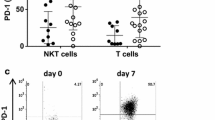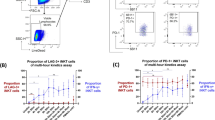Abstract
Invariant natural killer T (iNKT) cells are innate-like, lipid-reactive T lymphocytes known for their potent immunomodulatory properties. In addition to expressing and utilizing cytolytic effector molecules of their own against certain target cells, iNKT cells can be stimulated with α-galactosylceramide (α-GalCer) to augment the cytotoxic capacity of natural killer (NK) cells. Herein, we describe a flow cytometry-based in vivo killing assay that enables examination of α-GalCer-promoted cytotoxicity against β2 microglobulin knockout (β2M−/−) target cells, which mimic tumor and virus-infected cells displaying little to no MHC class I molecules on their surface. Using an anti-asialo GM1 antibody, which depletes NK cells but not iNKT cells, we confirmed that the increased clearance of β2M−/− cells in α-GalCer-primed recipients was mediated by NK cells. The protocol detailed here can be leveraged to assess the functional fitness of iNKT cells and their crosstalk with NK cells and to further our understanding of α-GalCer-promoted cytotoxicity in preclinical immunotherapeutic applications.
Access this chapter
Tax calculation will be finalised at checkout
Purchases are for personal use only
Similar content being viewed by others
References
Lantz O, Bendelac A (1994) An invariant T cell receptor alpha chain is used by a unique subset of major histocompatibility complex class I-specific CD4+ and CD4-8- T cells in mice and humans. J Exp Med 180(3):1097–1106. https://doi.org/10.1084/jem.180.3.1097
Bendelac A, Lantz O, Quimby ME et al (1995) CD1 recognition by mouse NK1+ T lymphocytes. Science 268(5212):863–865. https://doi.org/10.1126/science.7538697
Kawano T, Cui J, Koezuka Y et al (1997) CD1d-restricted and TCR-mediated activation of valpha14 NKT cells by glycosylceramides. Science 278(5343):1626–1629. https://doi.org/10.1126/science.278.5343.1626
Matsuda JL, Mallevaey T, Scott-Browne J et al (2008) CD1d-restricted iNKT cells, the “Swiss-Army knife” of the immune system. Curr Opin Immunol 20(3):358–368. https://doi.org/10.1016/j.coi.2008.03.018
Arora P, Baena A, Yu KO et al (2014) A single subset of dendritic cells controls the cytokine bias of natural killer T cell responses to diverse glycolipid antigens. Immunity 40(1):105–116. https://doi.org/10.1016/j.immuni.2013.12.004
Carnaud C, Lee D, Donnars O et al (1999) Cutting edge: cross-talk between cells of the innate immune system: NKT cells rapidly activate NK cells. J Immunol 163(9):4647–4650
Hayakawa Y, Takeda K, Yagita H et al (2001) Critical contribution of IFN-gamma and NK cells, but not perforin-mediated cytotoxicity, to anti-metastatic effect of alpha-galactosylceramide. Eur J Immunol 31(6):1720–1727
Smyth MJ, Crowe NY, Pellicci DG et al (2002) Sequential production of interferon-gamma by NK1.1(+) T cells and natural killer cells is essential for the antimetastatic effect of alpha-galactosylceramide. Blood 99(4):1259–1266. https://doi.org/10.1182/blood.v99.4.1259
Kakimi K, Guidotti LG, Koezuka Y et al (2000) Natural killer T cell activation inhibits hepatitis B virus replication in vivo. J Exp Med 192(7):921–930. https://doi.org/10.1084/jem.192.7.921
van Dommelen SL, Tabarias HA, Smyth MJ et al (2003) Activation of natural killer (NK) T cells during murine cytomegalovirus infection enhances the antiviral response mediated by NK cells. J Virol 77(3):1877–1884. https://doi.org/10.1128/jvi.77.3.1877-1884.2003
van den Heuvel MJ, Garg N, Van Kaer L et al (2011) NKT cell costimulation: experimental progress and therapeutic promise. Trends Mol Med 17(2):65–77. https://doi.org/10.1016/j.molmed.2010.10.007
Fujii SI, Shimizu K (2019) Immune networks and therapeutic targeting of iNKT cells in cancer. Trends Immunol 40(11):984–997. https://doi.org/10.1016/j.it.2019.09.008
Haeryfar SM, Mallevaey T (2015) Editorial: CD1- and MR1-restricted T cells in antimicrobial immunity. Front Immunol 6:611. https://doi.org/10.3389/fimmu.2015.00611
Dascher CC (2007) Evolutionary biology of CD1. Curr Top Microbiol Immunol 314:3–26. https://doi.org/10.1007/978-3-540-69511-0_1
Kjer-Nielsen L, Borg NA, Pellicci DG et al (2006) A structural basis for selection and cross-species reactivity of the semi-invariant NKT cell receptor in CD1d/glycolipid recognition. J Exp Med 203(3):661–673. https://doi.org/10.1084/jem.20051777
Brossay L, Chioda M, Burdin N et al (1998) CD1d-mediated recognition of an alpha-galactosylceramide by natural killer T cells is highly conserved through mammalian evolution. J Exp Med 188(8):1521–1528. https://doi.org/10.1084/jem.188.8.1521
Choi J, Meilleur CE, Haeryfar SMM (2019) Tailoring in vivo cytotoxicity assays to study Immunodominance in tumor-specific CD8+ T cell responses. J Vis Exp 147. https://doi.org/10.3791/59531
Haeryfar SM, DiPaolo RJ, Tscharke DC et al (2005) Regulatory T cells suppress CD8+ T cell responses induced by direct priming and cross-priming and moderate immunodominance disparities. J Immunol 174(6):3344–3351. https://doi.org/10.4049/jimmunol.174.6.3344
Memarnejadian A, Meilleur CE, Shaler CR et al (2017) PD-1 blockade promotes epitope spreading in anticancer CD8(+) T cell responses by preventing fratricidal death of subdominant clones to relieve Immunodomination. J Immunol 199(9):3348–3359. https://doi.org/10.4049/jimmunol.1700643
Meilleur CE, Wardell CM, Mele TS et al (2019) Bacterial Superantigens expand and activate, rather than delete or incapacitate, preexisting antigen-specific memory CD8+ T cells. J Infect Dis 219(8):1307–1317. https://doi.org/10.1093/infdis/jiy647
Meilleur CE, Memarnejadian A, Shivji AN et al (2020) Discordant rearrangement of primary and anamnestic CD8+ T cell responses to influenza a viral epitopes upon exposure to bacterial superantigens: implications for prophylactic vaccination, heterosubtypic immunity and superinfections. PLoS Pathog 16(5):e1008393. https://doi.org/10.1371/journal.ppat.1008393
Oberg L, Johansson S, Michaëlsson J et al (2004) Loss or mismatch of MHC class I is sufficient to trigger NK cell-mediated rejection of resting lymphocytes in vivo - role of KARAP/DAP12-dependent and -independent pathways. Eur J Immunol 34(6):1646–1653. https://doi.org/10.1002/eji.200424913
Wingender G, Krebs P, Beutler B et al (2010) Antigen-specific cytotoxicity by invariant NKT cells in vivo is CD95/CD178-dependent and is correlated with antigenic potency. J Immunol 185(5):2721–2729. https://doi.org/10.4049/jimmunol.1001018
Memarnejadian A, Meilleur CE, Mazzuca DM et al (2016) Quantification of alloantibody-mediated cytotoxicity in vivo. Transplantation 100(5):1041–1051. https://doi.org/10.1097/tp.0000000000001154
Choi J, Rudak PT, Lesage S et al (2019) Glycolipid stimulation of invariant NKT cells expands a unique tissue-resident population of precursors to mature NK cells endowed with oncolytic and Antimetastatic properties. J Immunol 203(7):1808–1819. https://doi.org/10.4049/jimmunol.1900487
Rudak PT, Choi J, Parkins KM et al (2021) Chronic stress physically spares but functionally impairs innate-like invariant T cells. Cell Rep 35(2):108979. https://doi.org/10.1016/j.celrep.2021.108979
Vivier E, Tomasello E, Baratin M et al (2008) Functions of natural killer cells. Nat Immunol 9(5):503–510. https://doi.org/10.1038/ni1582
Nakagawa R, Nagafune I, Tazunoki Y et al (2001) Mechanisms of the antimetastatic effect in the liver and of the hepatocyte injury induced by alpha-galactosylceramide in mice. J Immunol 166(11):6578–6584. https://doi.org/10.4049/jimmunol.166.11.6578
Schmieg J, Yang G, Franck RW et al (2003) Superior protection against malaria and melanoma metastases by a C-glycoside analogue of the natural killer T cell ligand alpha-Galactosylceramide. J Exp Med 198(11):1631–1641. https://doi.org/10.1084/jem.20031192
Fujii S, Shimizu K, Hemmi H et al (2006) Glycolipid alpha-C-galactosylceramide is a distinct inducer of dendritic cell function during innate and adaptive immune responses of mice. Proc Natl Acad Sci U S A 103(30):11252–11257. https://doi.org/10.1073/pnas.0604812103
Acknowledgments
Our ongoing studies on invariant T cells are supported through operating grants provided to SMMH by the Canadian Institutes of Health Research (PJT-156295), the Natural Sciences and Engineering Research Council of Canada (NSERC) (04706-2019 RGPIN), and the Canadian Cancer Society (706396). PTR was an NSERC Alexander Graham Bell Canada Graduate Scholar (CGS—Doctoral).
Author information
Authors and Affiliations
Corresponding author
Editor information
Editors and Affiliations
Rights and permissions
Copyright information
© 2021 The Author(s), under exclusive license to Springer Science+Business Media, LLC, part of Springer Nature
About this protocol
Cite this protocol
Rudak, P.T., Haeryfar, S.M.M. (2021). In Vivo Cytotoxicity by α-GalCer-transactivated NK Cells. In: Liu, C. (eds) Invariant Natural Killer T-Cells. Methods in Molecular Biology, vol 2388. Humana, New York, NY. https://doi.org/10.1007/978-1-0716-1775-5_15
Download citation
DOI: https://doi.org/10.1007/978-1-0716-1775-5_15
Published:
Publisher Name: Humana, New York, NY
Print ISBN: 978-1-0716-1774-8
Online ISBN: 978-1-0716-1775-5
eBook Packages: Springer Protocols




